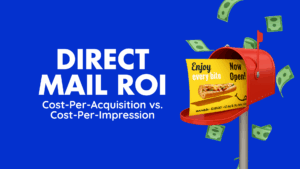
When it comes to measuring marketing success, most business owners focus on one big question: What am I getting for my money?
That’s where two key metrics come into play — Cost Per Impression (CPI) and Cost Per Acquisition (CPA). Both can reveal valuable insights about your campaign performance, but when it comes to direct mail, one of them truly tells the full story.
Understanding the Two Metrics
Cost Per Impression (CPI) measures how much you pay every time your marketing message is seen.
It’s a common metric in digital advertising — think of it as the price tag for visibility. If you spend $1,000 to send 10,000 postcards, your CPI is $0.10 per impression.
It’s a great way to gauge reach and brand awareness, but it doesn’t always tell you how effective your message is at driving conversions.
Cost Per Acquisition (CPA), on the other hand, measures how much you spend to acquire a new customer.
If your direct mail campaign costs $2,000 and generates 40 new customers, your CPA is $50. This number gives you a clear picture of ROI — how much you’re paying for real results, not just eyeballs.
Why CPI Alone Doesn’t Tell the Whole Story
Impressions are important — after all, no one can buy from you if they don’t know you exist. But when you only measure impressions, you’re only measuring exposure, not impact.
Digital ads often boast low CPIs but struggle with attention and trust. Studies show that consumers scroll past online ads in less than 2 seconds, while direct mail is physically held, read, and remembered longer.
In other words: not all impressions are created equal.
Direct Mail and the Power of Real Engagement
With direct mail, your “impression” goes much deeper. Recipients often spend 30 seconds or more reading a postcard — long enough to process the offer, brand, and call-to-action.
Better yet, direct mail has a higher response rate (4.9%) compared to most digital channels, which hover below 1%. That means you’re not just getting seen — you’re getting results.
When you look at CPA for direct mail, it often outperforms digital ads in customer acquisition. Why? Because physical mail builds trust and sticks around — on kitchen counters, bulletin boards, and refrigerators — long after the first impression.
How to Lower Your CPA with Direct Mail
A few smart strategies can help reduce your acquisition cost while boosting ROI:
-
Target smarter: Use tools like Taradel’s Mapfire targeting to mail only to high-potential ZIP codes or households that match your ideal customer profile.
-
Use frequency to your advantage: Campaigns with 3+ mail drops outperform one-time sends by reinforcing your brand and increasing conversion rates.
-
Pair with digital channels: Integrate Google or Facebook retargeting ads to boost response and keep costs low across channels.
-
Test and refine offers: Track which postcards, offers, or designs generate the most conversions — then scale up what works.
Which Metric Matters More?
Both CPI and CPA have their place, but CPA is the real measure of ROI.
Cost Per Impression tells you how much attention you’re getting.
Cost Per Acquisition tells you how much growth you’re creating.
For service-based businesses, small local shops, or franchise owners using Every Door Direct Mail (EDDM), the ultimate goal isn’t just awareness — it’s action.
When you focus on CPA, you can measure exactly how efficiently your direct mail drives new customers and revenue.
The Takeaway
If you’re chasing awareness, track CPI.
If you’re chasing real growth, track CPA.
Direct mail delivers both — meaningful impressions and measurable conversions — making it one of the most cost-effective ways to drive ROI in 2025 and beyond.

